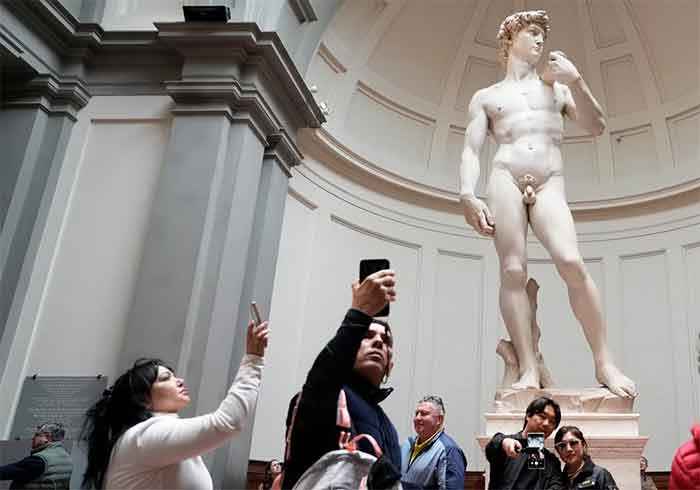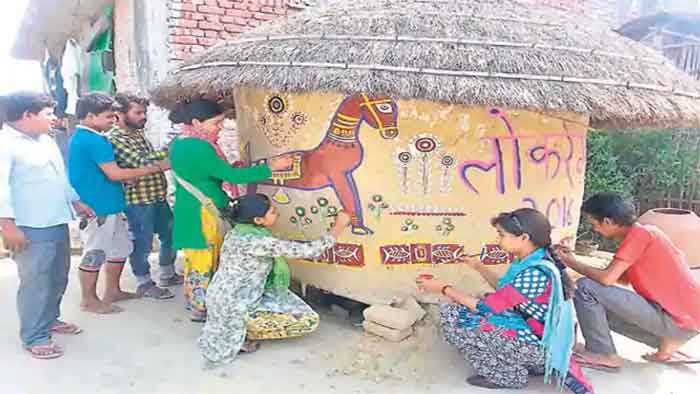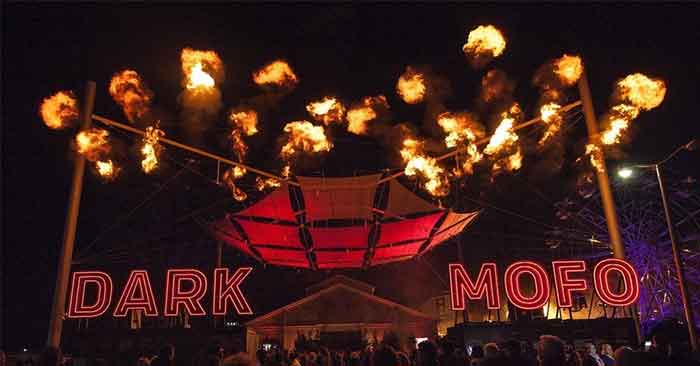
Lok Laya is an annual festival of folk arts, music and dance of Bundelkhand organized in Chitrakut district by Samaj Seva Sansthaan , along with the involvement and support of other organizations, which has become a meeting and solidarity point for several performing folk artists of the region scattered in various remote villages. They wait eagerly for the invitation and the endearing phone call from the main organizer, Gaya Prasad Gopal or simply Gopal Ji.
A social activist who worked all his life for weaker sections, Gopal Ji is now 85 years old and is generally addressed as Pita ji by the younger generation of artists and activists. Gopal grew up as a child in Bigahna village which is known for some of its simple, small farmers being accomplished dhrupad singers. They would cultivate their fields in the daytime and gather in the evening for music. These singers include Rambahori, Parasram, Kamta Prasad and Ramvjay. This news had attracted a lot of attention when broadcast on radio some decades back. Gopal, growing up in this village in the company of such accomplished singers, had a strong feeling that there isn’s such a wide gap or barrier between classical and folk music as is often taken for granted. This was confirmed by later experiences. A famous dhrupad singer told a folk singer from a tribal community who had just given a great performance at a Lok Laya festival—It is your singing of old days to which we trace origin of our own music.

As Gopal had been working among the weakest sections on land, justice and related issues, he soon realized that very rich folk song and dance forms exist among the weaker sections of society, including the tribal communities and dalits of Bundelkhand region. However when he tried to reach out to them, he found that they were so poor that it would be unfair to ask them to come to any performing centre without arranging for their travel. Hence he started looking for donors who could pay the travel and other expenses plus a modest honorarium. After this the Lok Laya festival started and nine such festivals have been held so far in the campus of this organization in Chitrakut district (Uttar Pradesh).
However the difficulties in which many artists continue to live has become an increasing concern and Gopal has been pleading with the government to take more steps for ensuring livelihood support to these artists based on their valuable arts and skills.
Ramjivan’s parents worked as bonded labourers in Bharkhari village of Hamirpur district (U.P.). When he was in class four he was forced by his parents’ employers to take their cattle for grazing. As he grew up, he spent his nights learning nautanki songs and Raawla dance. In a few years by sheer dedication and hard work he emerged as one of the most accomplished folk artists of the area famous for his tamboora singing and kabiri. Yet he continued to grapple with poverty and survival.
Naurangilal, born in a family of traditional sanitation workers, experienced extreme forms of untouchability and other humiliations from early childhood in Bakurkhurd village (Hamirpur district). A more interesting part of his father’s traditional professional was to play various instruments at weddings. Naurangilal was fascinated by this and he soon became an accomplished player of dafla.
What is common to both these folk artists is that they got enthusiastic response at Lok Laya (which literally means Rhythm of People).
Gopal ji travelled far and wide in rural areas to establish contacts with such unknown folk artists of great skills and accomplishments. He collected books and documents on folk arts and also established contacts with various scholars who were working as this issue.
What Gopal ji found in the course of this huge effort was that many accomplished folk artists are living in great economic difficulties. Families of several of them could not get two square meals a day and they had to toil as migrant workers to survive. In such a situation there was little incentive to hand over their skills to the next generation.
On the other hand, Gopal says that he also comes across cases of resilience and strength of folk arts and artists to survive against heavy odds, thanks mainly to their integration with the social fabric of villages. This effort was being supported by persons like Dr. Ram Bhajan in Hamirpur district who left his job to help folk artists of Vinvaar and neighbouring villages in the revival of folk arts. Efforts of Krishna Mohan Saxena and Vijay Srivastava helped Nautanki artists in and around Banda district, scholars like Dr. Veena Srivastava, Dr. Madhu Shukla and Ayodhya Kumud were helping to document important aspects of Bundelkhand’s folk arts in their research work and books. Social programs like PACS, organizations like PRIA and Sahbhagi have also donated for this cause from time to time.
These festivals were well-covered by local media and helped to generate a region-wide interest in the protection and strengthening of folk arts.
At a typical Lok Laya festival the beauty and vitality of folk-arts is very much in evidence. The presentations of occupational and caste-groups such as dhobis (washerfolk), Kahars (water-providers), kumhars (potters) and kachis (vegetable growers) were widely appreciated. As Lallu Ram Shukla of Music Dept. of Chitrakut University explained, these attract audience of the entire village community and such performances which continue all night help to strengthen the social fabric of rural life.
Even more lively were the presentations of ‘Rai’ and ‘Kolhai’ folk arts by Kol tribal artists. A new generation of kol women like Booti Kol have left behind the cruel legacy of bonded labour to emerge as panchayat leaders and in addition they are very good folk artists.
Dr. Ram Bhajan has explained that talented women artists who inherit and develop great skills in their maternal homes are often discouraged from performing after their marriage.They and their families should be approached and encouraged to develop the talent further. He gave the example of Siyapyari Ahirwar who has emerged as one of the most celebrated artists after efforts to re-discover and encourage her talent were made.
Dr. Veena Srivastava has pointed out that several folk artists of Bundelkhand have a special talent for combining singing, dancing and playing an instrument at the same time.
Dr. Madhu Shukla has said that even the modest amounts sanctioned for folk artists generally fail to reach the truly deserving artists. She stated at a Lok Laya function that performers such as those seen at Lok Laya are true folk artists, but clever urban artists just take a few tips from them to emerge as more popular figures at urban stage and also corner more funds and fame.
Gopal ji has stated that the existing disbursal of funds for folk arts needs to be carefully re-examined so that complete transparency and honesty along with the right priorities can be ensured. He has made a strong plea for the government giving much more attention to the protection of folk arts and artists.
Bharat Dogra is Honorary Convener, Campaign to Save Earth Now. His recent books include Hindi Cinema and Society, Man over Machine and When the Two Streams Met.













































